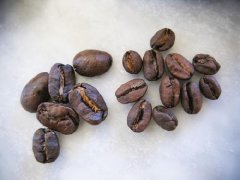Baking skills of European baker Jiang Chengze and Zhang Jinming
European baker double baking method: caramel lemon juice
The elegant sour aroma of light roasted coffee is the most attractive, but it lacks the richness, smoothness and mellowness of medium or deep roasting, which is what the cup test calls body. Jiang Chengze and his partner Zhang Jinming discuss coffee aroma, balance and bean matching every day. One day, Zhang Jinming indulged in the aroma of cooking rice, blessed to the soul, and came up with a new method of double stir-frying, so the two tried to bake the cup many times and found that this method could change the tone and taste of light or medium baking, and could strike a balance with aroma. It has become the secret baking method for European bakers.
Jiang Chengze originally named this method Core-Shell' baking. Core-Shell is a term used in material technology, meaning that in the core-shell structure, the doped elements dissolve into the lattice, forming a shell that wraps the core region. The shell part is often a variant structure caused by impurities, while the core part is still the original structure. After listening to Mr. Han, he suggested that he should change his name to 'European Baker double Baking method'.
General double frying is before the arrival of an explosion, beans before a large-scale Mena reaction and caramelization, must be out of the oven, and then collected overnight or a few days later, and then into the oven to fry. However, the 'European baker double baking method' enters the beginning of an explosion, dense explosion or an explosion end, you can first come out of the furnace to cool, depending on your baking degree, then raise the furnace temperature to 250℃ to 270℃ (Taiwan-made Yang family roaster), and then stir-fry the shallowly roasted beans in a pan for 30 to 40 seconds. This is like fried food to be delicious, will first into the low-temperature oil pan, and then into the high-temperature oil pan to fry.
This improved double roasting method not only retains the elegant fruit rhyme of shallow roasted beans, but also has the body feeling of medium and deep roasting, which makes the shallow roasted coffee taste more skeletal, caramel more obvious, not too tart, and the flavor and taste are good.

Important Notice :
前街咖啡 FrontStreet Coffee has moved to new addredd:
FrontStreet Coffee Address: 315,Donghua East Road,GuangZhou
Tel:020 38364473
- Prev
Cold knowledge | Nine details to pay attention to when grinding coffee beans!
For professional baristas, please follow the coffee workshop (Wechat official account cafe_style) Grind Your Coffee Bean 1. Different brewing equipment is suitable for different grinding degrees, the finer the grinding, the easier to bring out the substances of coffee, but not all of these substances will be our favorite flavor. two。 Coffee beans with different roasting degrees will also affect the grinding results because the shallow roasted beans are harder and more structural.
- Next

Elephant bean Maragogype introduces how elephant beans bake Tibica mutant beans
Elephant beans (Maragogype): beans are at least three times larger than the average Arabica, making it the largest in the world, hence the name. Elephant beans, the most well-known variety of Tibica beans, were first discovered in the Maragogype region of Bahia in northeastern Brazil in 1870. The high-quality bean industry is often called the birthplace of Malago Gibbs, commonly known as elephant beans. Mexico, melon land
Related
- Beginners will see the "Coffee pull flower" guide!
- What is the difference between ice blog purified milk and ordinary milk coffee?
- Why is the Philippines the largest producer of crops in Liberia?
- For coffee extraction, should the fine powder be retained?
- How does extracted espresso fill pressed powder? How much strength does it take to press the powder?
- How to make jasmine cold extract coffee? Is the jasmine + latte good?
- Will this little toy really make the coffee taste better? How does Lily Drip affect coffee extraction?
- Will the action of slapping the filter cup also affect coffee extraction?
- What's the difference between powder-to-water ratio and powder-to-liquid ratio?
- What is the Ethiopian local species? What does it have to do with Heirloom native species?

